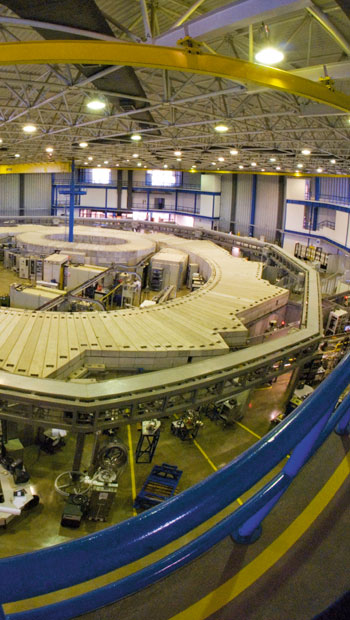 EDUARDO CESARThose who have already worked with synchrotron light to study proteins, fossil bones, rocks, medicines or materials for computers adjusted their work plans as a result of seeing what other research groups are doing. Moreover, those who just a short while ago hardly knew anything about this field have seen that this type of light can have academic and industrial applications. From January 17 to 25, 18 experts from 6 countries – including a Nobel laureate in Chemistry and another in Physics – spent time with researchers along with 76 graduate students from 24 countries (13 of whom were Brazilian) during the São Paulo School of Advanced Science (ESPCA) of the National Laboratory of Synchrotron Light (LNLS) held in Campinas. The ESPCA is an event launched in 2009 by FAPESP in order to finance the setting up of short courses in advanced research in São Paulo state, in various fields of knowledge.
EDUARDO CESARThose who have already worked with synchrotron light to study proteins, fossil bones, rocks, medicines or materials for computers adjusted their work plans as a result of seeing what other research groups are doing. Moreover, those who just a short while ago hardly knew anything about this field have seen that this type of light can have academic and industrial applications. From January 17 to 25, 18 experts from 6 countries – including a Nobel laureate in Chemistry and another in Physics – spent time with researchers along with 76 graduate students from 24 countries (13 of whom were Brazilian) during the São Paulo School of Advanced Science (ESPCA) of the National Laboratory of Synchrotron Light (LNLS) held in Campinas. The ESPCA is an event launched in 2009 by FAPESP in order to finance the setting up of short courses in advanced research in São Paulo state, in various fields of knowledge.
“We want to increase the laboratory’s visibility for potential researchers from overseas,” explained Antonio José Roque da Silva, LNLS director. “At present, when we are beginning the project for a new ring of light, we must look ahead to the future and at what others are doing.” Named Sirius, the new ring should have a circumference of 460 meters – the current one measures 93 meters – and a lot more energy (see “The brightest light“, Pesquisa FAPESP nº 172). The only synchrotron light source in Latin America and one of the only two in the Southern Hemisphere (the other one is in Australia), the LNLS serves researchers and companies from Brazil and other countries.
Sometimes, there is a great contrast in relation to other countries. “While many Brazilian companies are still trying to figure out how to use synchrotron light to improve the quality of their products, the Japanese company Toyota already has its own line,” says Silva. Formerly a user of the European Synchrotron Radiation Facility (ESRF), in Grenoble, France, the company decided to build its own line, which has been in operation in Japan since 2009. Gemma Guillera, a researcher who cooperated with Toyota, said that this line of light should provide support for the development of new catalysts to reduce pollutants from batteries and from fuel cells. “The spectroscopy of absorption of X-rays [one of the types of analysis by means of synchrotron light used by the Toyota team] provides information about the lengths of atomic connections, the type and the number of atoms,” she explained.
Researchers and students saw how surveys emerge – and how long they can take to produce grandiose results. Israel’s Ada Yonath said that she worked for almost 30 years in her laboratory at the Weizmann Institute in Israel, as well as on synchrotron light sources in the United States, in Germany and in Brazil until she unlocked the structure and the function of cell components known as ribosomes, which are essential to the production of proteins.
In order to make progress, she and other specialists had to obtain crystals of these cellular components, something that had been regarded as impossible for decades, but which was finally achieved by cooling the cells. Mastery of this technique and the resulting leap in knowledge about ribosomes earned her and two other researchers – Venkatraman Ramakrishnan, from the Molecular Biology Laboratory at Cambridge, England, and Thomas Steitz, from Yale University in the United States – the Nobel Prize for Chemistry in 2009. At the end of the presentation, she thanked the Weizmann Institute “for having allowed me to pursue my dreams.”
New memories
The French physicist Albert Fert, a researcher at the National Center for Scientific Research (CNRS) and one of the winners of the Nobel Prize for Physics in 2007, spoke of the fundamentals and applications of spintronics, a new kind of electronic that does not exploit the electrical charge, but rather another property: the spin (direction of rotation) of the electrons. This is the basis of the more powerful computer memories that companies in the United States, France and Japan are expected to launch in the next few years.
Fert and the German physicist Peter Grünberg were awarded the Nobel Prize in Physics in 2007 for their simultaneous identification, in 1988, of giant magnetoresistance, a quantum mechanics effect observed in materials made from magnetic and non-magnetic materials that results in an intense variation of the electrical resistance with the magnetic field. This effect enabled an expansion of the computer memory and also of mobile phone handsets, which should now get another boost, thanks to a new generation of devices based on spintronics.
Those who had lunch with Fert noted that he not only enjoys thinking about the computers of the future, but also about his holidays. Close to his 73rd birthday, which he will celebrate in March of this year, Fert windsurfs, normally in France or in the Caribbean. He has already been to Botafogo in Rio de Janeiro on two occasions, not to talk about physics, but to surf.
Republish